Networking professionals and developers often encounter terms like 127.0.0.1:62893 during troubleshooting or testing phases. This technical identifier, rooted in the basics of computer networking, plays a critical role in local communication within a computer system.
Whether you’re curious about its purpose, want to know how it works, or need to troubleshoot issues, this article will provide everything you need to understand and utilize 127.0.0.1:62893 effectively.
What is 127.0.0.1:62893?
The term 127.0.0.1 refers to the localhost IP address, a loopback interface within the networking architecture of any modern device. The number 62893 designates a specific port utilized for communication. Together, 127.0.0.1:62893 defines a local connection endpoint useful for internal data transfers or testing purposes.
Using this configuration avoids sending requests over the internet, ensuring privacy and speed during testing.
The Importance of Localhost
The localhost, represented by 127.0.0.1, serves as a placeholder for internal networking tasks. When you communicate with this address, you bypass external systems entirely, restricting traffic to the originating machine. This behavior is invaluable for:
- Testing applications in development.
- Running isolated server simulations.
- Diagnosing network issues securely.
Understanding Port 62893
A port number like 62893 functions as a logical endpoint for network communications. Software applications rely on these ports to send and receive data. When coupled with 127.0.0.1, the combination points to a specific service or process running on your local machine.
For instance, developers might configure this port for testing server responses or monitoring applications without affecting production environments.
How 127.0.0.1:62893 Works in Networking
Communication within 127.0.0.1:62893 revolves around the Transmission Control Protocol (TCP) or User Datagram Protocol (UDP). Here’s how it operates:
- Step 1: A program initiates a request.
The originating software uses 127.0.0.1:62893 as its destination for sending internal data. - Step 2: Data packets are encapsulated.
Networking layers wrap the payload with headers, including source and destination information. - Step 3: Data is looped back.
The operating system intercepts and processes the request without involving external devices.
Use Cases for 127.0.0.1:62893
Local Development and Testing
Web developers and system administrators use 127.0.0.1:62893 to:
- Simulate server environments.
- Test APIs for accuracy.
- Debug software applications under isolated conditions.
Diagnostics and Troubleshooting
When diagnosing network errors, this address can confirm whether connectivity issues stem from external factors or internal misconfigurations.
Common Issues with 127.0.0.1:62893
Port Conflicts
If multiple applications attempt to use port 62893, a conflict may occur. Resolving such issues involves:
- Identifying which process occupies the port using tools like
netstat. - Reassigning the conflicting service to a different port.
Firewall Restrictions
Occasionally, firewall settings block loopback traffic. Adjusting these settings allows uninterrupted data flow.
Configuration Errors
Misconfigured software might fail to recognize 127.0.0.1:62893. Double-checking application settings resolves this problem.
How to Test 127.0.0.1:62893
Testing connectivity ensures the address and port function as intended.
- Use Command-Line Tools:
- Enter
ping 127.0.0.1in the terminal to verify the localhost’s responsiveness. - Run
telnet 127.0.0.1 62893to confirm access to the specific port.
- Enter
- Employ Port Scanners:
Applications like Nmap provide insights into port activity and potential issues. - Monitor Logs:
Check system or application logs for detailed information on errors related to 127.0.0.1:62893.
Security Implications of 127.0.0.1:62893
Though generally secure, misuse of localhost ports can lead to vulnerabilities.
Best Practices:
- Restrict external access: Only allow local connections to 127.0.0.1:62893.
- Monitor suspicious activity: Log any unexpected attempts to use this port.
- Patch regularly: Keep software up to date to close security loopholes.
127.0.0.1:62893 in Development Environments
Advantages:
- Speeds up testing by eliminating external delays.
- Reduces risks of exposing sensitive data during debugging.
- Simplifies error isolation.
Example Scenarios:
Developers often configure web servers to listen on 127.0.0.1:62893 while fine-tuning APIs, ensuring that only authorized testers can interact with the system.
Configuring 127.0.0.1:62893 for Your Needs
On Windows
- Open the Command Prompt as Administrator.
- Use the
netshcommand to assign ports.
On macOS/Linux
- Edit the
/etc/hostsfile to define custom settings. - Use tools like
iptablesto manage port rules.
127.0.0.1:62893 in Cloud Computing
In cloud-hosted virtual machines, 127.0.0.1:62893 plays a similar role in isolating processes. Developers can replicate localhost testing environments across platforms like AWS or Azure.
FAQs
Why is 127.0.0.1 called the localhost?
The address points to the loopback interface, designed for internal system communications.
How do I resolve a port conflict on 127.0.0.1:62893?
Identify the conflicting process and reassign it to a different port.
Can I access 127.0.0.1:62893 from another computer?
No, localhost addresses are restricted to the originating device.
Why is 62893 chosen as a port number?
The number is arbitrary but must not conflict with other active services.
What tools can test 127.0.0.1:62893?
Tools like ping, telnet, and Nmap help verify connectivity and diagnose issues.
How does 127.0.0.1:62893 enhance security?
By keeping traffic local, it reduces the risk of external interception.
Is 127.0.0.1:62893 relevant for modern networks?
Yes, especially in debugging and local testing scenarios.
Conclusion
The combination of 127.0.0.1:62893 remains a cornerstone of local networking tasks, from debugging applications to isolating server processes. Understanding its intricacies ensures effective troubleshooting, development, and enhanced system security. By following best practices and leveraging diagnostic tools, users can harness the power of localhost ports to optimize their workflows.





